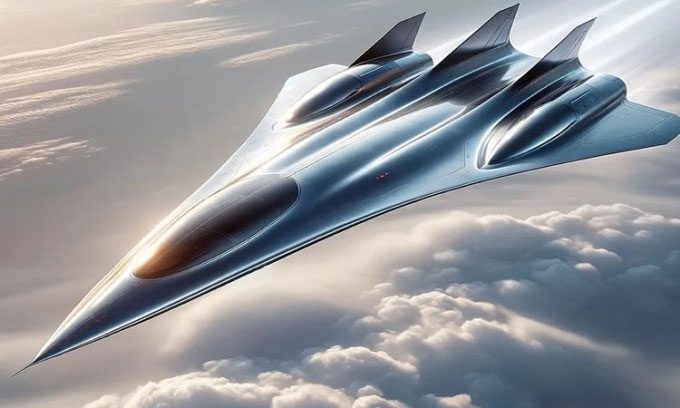A new hollow ceramic material designed by a Chinese research team retains its strength at temperatures of up to 2,000 degrees Celsius, making it highly suitable for producing protective shielding in aerospace applications.
Chinese scientists have developed a hollow ceramic material with high mechanical strength and necessary thermal insulation properties for aerospace applications, as reported by Interesting Engineering on January 23. This ceramic could even play a key role as an insulating material in the next generation of supersonic aircraft, according to Chu Yanhui, a scientist at South China University of Technology.

New hollow ceramic material can protect supersonic aircraft at high speeds. (Image: Dall-E).
The demand for hollow ceramic materials is increasing due to their excellent thermal insulation capabilities, combined with their ultra-lightweight characteristics, chemical inertness, and low thermal conductivity. However, achieving both high mechanical strength and thermal insulation simultaneously in hollow ceramics has been a challenge; as the material becomes more porous to enhance insulation, its mechanical strength significantly decreases. Shrinkage and loss of strength also occur when conventional porous materials are subjected to high temperatures, making them unsuitable for aerospace applications.
Nonetheless, the new ceramic developed by the research team at the School of Materials Science and Engineering at Guangzhou University features a multi-scale structural design that overcomes these limitations. In a study published in the journal Advanced Materials, Chu stated that the ceramic, named 9PHEB, demonstrates excellent strength and dimensional stability at temperatures up to 2,000 degrees Celsius, making it highly suitable for extreme conditions. The material is made up of nine components, all of which are positively charged ions. According to Chu, 9PHEB has a porosity of 50%, but its compressive strength is exceptionally high, at around 337 million pascals (MPa) at room temperature, significantly exceeding that of previous hollow ceramics.
The new ceramic also performed well in thermal stability and insulation tests, maintaining 98.5% of its strength even at 1,500 degrees Celsius. Unlike some traditional ceramics that often crack at high temperatures, 9PHEB exhibited plastic deformation when compressed at 2,000 degrees Celsius. When the material deformed at high temperatures, it experienced a tensile strength of 49%. This increased its strength to 690 MPa, more than double its previous value. Notably, high temperatures did not significantly affect the volume or size of the material, which only changed by about 2.4% after being heated to 2,000 degrees Celsius.
Chu explained that these mechanical and thermal properties result from the multi-scale design of the ceramic. This design includes tiny pores at a small scale, high-quality surfaces at the nanoscale, and lattice deformations at the atomic scale. The microstructure of the ceramic pores, in terms of size and distribution, plays a crucial role in the design. Approximately 92% of the pores are only about 0.8 – 1.2 micrometers in size. At the nanoscale, the ceramic features robust, defect-free bonds that enhance mechanical strength. At the atomic level, lattice deformation from the design helps improve hardness and reduce thermal conductivity. Together, these characteristics enhance the mechanical strength and thermal insulation of the material, making it suitable for use as shielding for supersonic aircraft.


















































